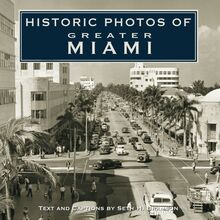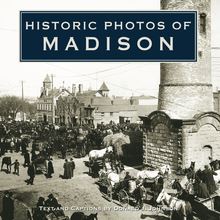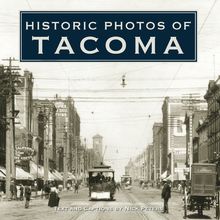Historic Photos of the Gateway Arch , livre ebook
191
pages
English
Ebooks
2009
Vous pourrez modifier la taille du texte de cet ouvrage
Obtenez un accès à la bibliothèque pour le consulter en ligne En savoir plus
Découvre YouScribe en t'inscrivant gratuitement
Découvre YouScribe en t'inscrivant gratuitement
191
pages
English
Ebooks
2009
Vous pourrez modifier la taille du texte de cet ouvrage
Obtenez un accès à la bibliothèque pour le consulter en ligne En savoir plus
Publié par
Date de parution
01 janvier 2009
Nombre de lectures
1
EAN13
9781618584359
Langue
English
Poids de l'ouvrage
7 Mo
St. Louis’ Gateway Arch rivals the monuments of the world in its simplicity, scale, elegance, and symbolism. The shimmering, stainless-steel ribbon forms a catenary arch 630 feet tall and 630 feet across at its base. Its design amazed the civic leaders determined to construct a great monument on the St. Louis riverfront. When it was completed, it wowed not just St. Louisans, not just Americans, but also visitors from around the world.
Its sleek geometric design and engineering was a creation of the Space Age, but the Arch was a monument to America’s frontier heritage. The Gateway Arch commemorated St. Louis’ riverfront as the Gateway to the West.
Historic Photos of the Gateway Arch chronicles the St. Louis riverfront from its days as a fur-trading post, to the creation of the Arch. From clearing the site to welding the first section into place, to the breathtaking moment of inserting the keystone—the photos tell the story.
Publié par
Date de parution
01 janvier 2009
Nombre de lectures
1
EAN13
9781618584359
Langue
English
Poids de l'ouvrage
7 Mo
HISTORIC PHOTOS OF
THE GATEWAY ARCH
T EXT AND C APTIONS BY N I N I H ARRIS
In this view facing west, the Gateway Arch graces the St. Louis riverfront, presiding over a rejuvenated city skyline.
HISTORIC PHOTOS OF
THE GATEWAY ARCH
Turner Publishing Company
200 4th Avenue North Suite 950
Nashville, Tennessee 37219
(615) 255-2665
www.turnerpublishing.com
Historic Photos of the Gateway Arch
Copyright 2009 Turner Publishing Company
All rights reserved.
This book or any part thereof may not be reproduced or transmitted in any form or by any means, electronic or mechanical, including photocopying, recording, or by any information storage and retrieval system, without permission in writing from the publisher.
Library of Congress Control Number: 2008908517
ISBN-13: 978-1-59652-512-2
Printed in China
09 10 11 12 13 14 15 16-0 9 8 7 6 5 4 3 2 1
C ONTENTS
A CKNOWLEDGMENTS
P REFACE
G ROUND OF I MMEASURABLE S IGNIFICANCE (1840 S -1940 S )
D ESIGNING THE M ONUMENT (1947)
A RCH O BSTACLES (1948-1959)
A M ONUMENTAL C ONSTRUCTION P ROJECT (1960-1967)
S YMBOL OF O PTIMISM AND U NITY (1968-R ECENT )
N OTES ON THE P HOTOGRAPHS
The campaign to establish a riverfront memorial honoring Thomas Jefferson for his vision of an expansive United States and the story this riverfront acreage played in America s westward expansion began in 1933. Aeroplane views of the old riverfront were used to sell the concept of creating the first national memorial to Thomas Jefferson. (The Jefferson Memorial in Washington, D.C., would not be dedicated until 1943.)
A CKNOWLEDGMENTS
This volume, Historic Photos of the Gateway Arch , is the result of the cooperation and efforts of many individuals and organizations. It is with great thanks that we acknowledge the valuable contribution of the National Park Service, Jefferson National Expansion Memorial, for their generous support.
We would also like to thank the following individuals for valuable contributions and assistance in making this work possible:
Bob Moore, Historian, Jefferson National Expansion Memorial, Department of the Interior
Jennifer R. Clark, C.A., Archivist, Jefferson National Expansion Memorial
Thomas Dewey, Librarian, Jefferson National Expansion Memorial
Kathleen Moenster, Assistant Curator, Jefferson National Expansion Memorial
-------
With the exception of touching up imperfections that have accrued with the passage of time and cropping where necessary, no other changes have been made. The focus and clarity of many images is limited to the technology and the ability of the photographer at the time they were taken.
P REFACE
The Gateway Arch reflects the history of tens of thousands of Americans for whom the St. Louis riverfront served as a funnel on their way to making the United States a nation that stretched from the Atlantic to the Pacific. The St. Louis riverfront witnessed early trade with the Indians, the rise of steamboat traffic on the western rivers, the settlers beginning their long journeys west by wagon, and the transcontinental railroad linking one coast of the United States to the other.
In 1933, St. Louisans first envisioned a memorial to commemorate the unparalleled role of their riverfront in the opening of the American frontier. Ninety acres of riverfront were designated the site of what was to be called the Jefferson National Expansion Memorial. The memorial would honor both the westward migration and President Thomas Jefferson, who had the vision to expand the nation s territory west of the Mississippi River with the Louisiana Purchase. The focal point of the site was to be an awe-inspiring monument.
Civic leaders wanted a monument that would symbolize the story of all American pioneers who had gone west. Some proposals mimicked traditional architectural models. Others were period pieces of the post-World War II era. One design, proposed by an American architect born in Finland, embodied symbolism that is direct, convincing, and timeless.
Eero Saarinen proposed an arch of welded, triangular, stainless-steel sections towering 630 feet over the grounds of the historic riverfront. Saarinen s design won the day. Construction of what is today known as the Gateway Arch began in 1962. Its engineering was audacious. Its construction workers, whose work site often dangled in midair, courageous.
From its conception to its dedication, the riverfront monument was three and a half decades in the making. It was first dreamed of at the beginning of the Great Depression. Through economic hardships, through wars, and through attempted and successful assassinations of American leaders, the city of St. Louis and the National Park Service kept planning, designing, engineering, and building the monument. The completed Gateway Arch achieved what Saarinen stated was a purpose of architecture, To fulfill [man s] belief in the nobility of his existence.
- NiNi Harris
This view facing southeast to the Old Court House shows nineteenth-century buildings in the background, and the cleared riverfront, railroad trestle, and river to the left. In 1930, the city courts moved from the grand, domed, nineteenth-century courthouse to the new, larger, Civil Courts Building. The courthouse then became home to civic and cultural groups. In 1940, the National Park Service took ownership of the building as part of the Jefferson National Expansion Memorial. The Park Service began an authentic restoration of the venerable structure.
G ROUND OF I MMEASURABLE S IGNIFICANCE
(1840 S -1940 S )
On February 14, 1764, thirty Frenchmen established a fur-trading post on what would one day be the site of the Gateway Arch. There the founders, the Laclede-Chouteau family, built up a fur trade with Indian tribes of the Missouri River region. In a larger sense, God and nature chose that piece of land for the trading post, determining that the post would grow into a frontier metropolis to feed American dreams of westward expansion and Manifest Destiny.
The site rested on a series of limestone outcroppings that rose from the banks of the Mississippi. Those bluffs, the first high ground below the confluence of the south-flowing Mississippi and Missouri rivers, protected the area from the constant threat of floods. This elevation made the area the ideal hub for the future trade that would follow this remarkable river network-in effect the emerging nation s first highway system-through the expansive wilderness that stretched from the Appalachians to the Rockies and south to the Gulf of Mexico.
After the Louisiana Purchase turned millions of acres of the Midwest and northwestern plains into American territory, the St. Louis riverfront provided explorers what they needed to continue their journey west. Traps, tools, guns, cowboy coffee, Bibles, covered wagons, and plows issued through this riverfront. It was here that the great explorations into the uncharted west-those of Lewis and Clark, Zebulon Pike, John C. Fremont-originated. Military troops, adventurers, miners, missionaries, mountain men, settlers, and sodbusters were all outfitted in early St. Louis.
Gradually St. Louis began producing, not just transporting, the tools and goods for westward expansion. Saddles for cavalrymen, cast-iron stoves for cabins, and eventually even tailored suits for Texas oilmen were made in St. Louis. During this era, the Eads Bridge was designed and built to span the Mississippi at St. Louis, opening to rail and wagon traffic in 1874. The bridge carried trains above the old riverfront district, to new warehouses and districts, slowly diminishing the role of the riverfront. Times would change, but the historical significance of the area remains immeasurable.
For more than a century, the site of the Gateway Arch hummed with the machinery of the expansion of a nation. In its importance, this site is perhaps unequaled in the history of the United States.
President Thomas Jefferson s Louisiana Purchase in 1803 slowly transformed St. Louis from a French fur-trading post into the staging area for the westward expansion of the United States. This frontispiece from the St. Louis City Directory of 1859-showing the busy riverfront, a paddle-wheel riverboat, a train engine, and the Old Court House-illustrates the story memorialized by the Gateway Arch.
During the 1840s, St. Louis boomed. Waves of potato-famine Irish and German revolutionaries debarked from riverboats on the St. Louis levee. Many decided to stay and build homes and communities in this city poised on the edge of the frontier. St. Louis more than quadrupled, with its population growing from 16,469 at the beginning of the decade to more than 74,000 in 1850.
St. Louisans built the Court House in stages, beginning in 1839. It served as a public forum. St. Louisans honored hometown volunteers returning from the War with Mexico at the courthouse. The Dred Scott Case, which forced the debate over slavery all the way to the U.S. Supreme Court, was first brought to trial in its courtrooms. This illustration appeared in one of many German publications featuring St. Louis and Missouri.
The Renaissance-style, cast-iron dome of the Court House was completed in 1861, while the dome of the U.S. Capitol was under construction. Situated on high ground, it provided a natural reviewing stand for military parades. The Court House had been the site of a spirited debate in 1849 over building a transcontinental railroad. It was here also that Missouri senator Thomas Hart Benton uttered the poetic phrase encouraging national expansion, Westward the course of Empire.
For a century the St. Louis riverfront was the emporium of the frontier, but to the locals, it was simply the busiest place in town. Riverboats lined its levee. Mountains of crates, bales, and barrels turned the levee into an obstacle course for teamsters, draft horses, and wagons. The Eads Bridge, opened in 1874, gradually moved commerce away from the riverfront, to stations and wa














